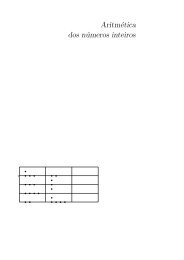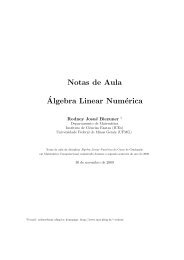GEOMETRIA B´ASICA - Arquivo Escolar
GEOMETRIA B´ASICA - Arquivo Escolar
GEOMETRIA B´ASICA - Arquivo Escolar
You also want an ePaper? Increase the reach of your titles
YUMPU automatically turns print PDFs into web optimized ePapers that Google loves.
ou seja, g é uma aplicação linear. Em particular, g é tal que g(0,0) = (0,0)<br />
Provar-se-á de seguida que esta aplicação g verifica<br />
com a 2 +b 2 = 1 e ǫ = ±1.<br />
g(x1,x2) = (ax1 −ǫbx2,bx1 +ǫax2) (∗)<br />
Suponha-se assim g uma isometria que verifica g(0,0) = (0,0), vamos provar que g tem a<br />
expressão (∗).<br />
Sejam E1 = (1,0) e E2 = (0,1), tem-se g(E1) = (a,b) e g(E2) = (c,d). Note-se que<br />
e, analogamente, c 2 +d 2 = 1.<br />
1 = OE1 = g(O)g(E1) = a 2 +b 2<br />
O ângulo ∠E1OE2 é recto porque −−→<br />
OE1 · −−→<br />
OE2 = 0 e então, como g preserva ângulos,<br />
∠g(E1)Og(E2) também é recto, logo<br />
Em resumo<br />
0 = −−−−→<br />
Og(E1)· −−−−→<br />
Og(E2) = (a,b)·(c,d) = ac+bd<br />
a 2 +b 2 = 1 (1) c 2 +d 2 = 1 (2) ac+bd = 0 (3)<br />
Se a=/ 0, isolando c em (3) obtem-se<br />
Substituindo em (2) obtem-se<br />
c = − bd<br />
a<br />
(4)<br />
1 = b2d2 a2 +d2 = d 2<br />
<br />
b2 +1 = d<br />
a2 2<br />
<br />
b2 +a2 a 2<br />
= d2<br />
a 2<br />
donde |a| = |d|. Usando (4), se a = d tem-se c = −b e se a = −d tem-se c = b.<br />
O caso a = 0 é directo, pois implica b = ±1 por (1) e d = −b por (3).<br />
Definição . 2.2 Aplicação ortogonal associada a uma isometria<br />
Seja f : R 2 −→ R 2 uma isometria do plano euclidiano definida analíticamente por<br />
f(x1,x2) = (q1 +ax1 −ǫbx2,q2 +bx1 +ǫax2) (ǫ = ±1)<br />
com (q1,q2) ∈ R 2 e a 2 +b 2 = 1. A aplicação linear −→ f definida por<br />
−→ f (x1,x2) = (ax1 −ǫbx2,bx1 +ǫax2)<br />
diz-se aplicação ortogonal associada à isometria f.<br />
105









